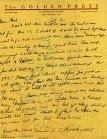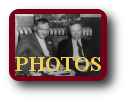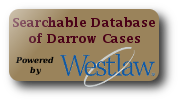The Bill Haywood Trial
"I want to say to you gentlemen, Bill Haywood can't die unless you kill him. You must tie the rope. You twelve men of Idaho, the burden will be on you. If at the behest of this mob you should kill Bill Haywood, he is mortal, he will die, but I want to say that a million men will grab up the banner of labor at the open grave where Haywood lays it down, and in spite of prisons or scaffolds or fire, in spite of prosecution or jury, or courts, these men of willing hands will carry it on to victory in the end."
– Clarence Darrow's closing argument to the jury in the murder trial of William Haywood, July 24, 1907."I wish to call attention to some of the startling doctrines of Mr. Darrow. . . . Personally, I like him very much but I do not like his doctrines as given to this jury. . . . When you heard these doctrines thus given to you . . . you must have said to yourselves at once, this man justifies murder, coldblooded, deliberate murder, openly in the courts of our country. If Haywood felt as his counsel feels, who speaks for him, if this is the creed of the W.F. of M., why should they not kill and murder? . . . Shame, oh shame, that one so gifted, one so blest with genius, has so far forgotten. The constitution was made for you. It is the shield of the weak."
– Prosecutor William E. Borah's closing argument to the jury in the murder trial of William Haywood, July 25, 1907.
|
June 4 -7, 1907. Contains direct and cross-examination of Harry Orchard. Courtesy Western Federation of Miners/International Union of Mine, Mill and Smelter Workers Papers, Archives, University of Colorado at Boulder Libraries.
Trial Transcripts, Haywood Trial, Volume 2, pp 505 - 958.
June, 8, 10, 11 1907. Contains continuation of cross-examination of Harry Orchard. Courtesy Western Federation of Miners/International Union of Mine, Mill and Smelter Workers Papers, Archives, University of Colorado at Boulder Libraries.
Trial Transcripts, Haywood Trial, Volume 3, pp 959 - 1582.
June 12, 13, 14, 15, 1907. Contains continuation of cross-examination of Harry Orchard. Courtesy Western Federation of Miners/International Union of Mine, Mill and Smelter Workers Papers, Archives, University of Colorado at Boulder Libraries.
Trial Transcripts, Haywood Trial, Volume 4, pp 1583 - 2123.
June 18, 19, 20, 21, 24, 1907. Courtesy Western Federation of Miners/International Union of Mine, Mill and Smelter Workers Papers, Archives, University of Colorado at Boulder Libraries.
Trial Transcripts, Haywood Trial, Volume 5, pp 2124 - 2839.
June 25, 26, 27, 28, 29, 1907. Courtesy Western Federation of Miners/International Union of Mine, Mill and Smelter Workers Papers, Archives, University of Colorado at Boulder Libraries.
Trial Transcripts, Haywood Trial, Volume 6, pp 2840 - 3380.
July 1, 2, 3, 5, 1907. Courtesy Western Federation of Miners/International Union of Mine, Mill and Smelter Workers Papers, Archives, University of Colorado at Boulder Libraries.
Trial Transcripts, Haywood Trial, Volume 7, pp 3380 - 3722.
July 8, 9 1907. Courtesy Western Federation of Miners/International Union of Mine, Mill and Smelter Workers Papers, Archives, University of Colorado at Boulder Libraries.
Trial Transcripts, Haywood Trial, Volume 8, pp 3722 - 4041.
July 10th & 11th 1907. Contains William D. Haywood's testimony. Clarence Darrow's copy from the Papers of Clarence Darrow.
Trial Transcripts, Haywood Trial, Volume 9, pp 4042 - 4302.
July 12, 13 1907. Contains William D. Haywood''s testimony. Courtesy Western Federation of Miners/International Union of Mine, Mill and Smelter Workers Papers, Archives, University of Colorado at Boulder Libraries.
Trial Transcripts, Haywood Trial, Volume 10, pp 4303 - 4731.
July 15, 16, and 17, 1907. Courtesy Western Federation of Miners/International Union of Mine, Mill and Smelter Workers Papers, Archives, University of Colorado at Boulder Libraries.
Trial Transcripts, Haywood Trial, Volume 11.
July 18 - 30, 1907. Final arguments of the prosecution and defense, jury instructions and verdict. Courtesy Western Federation of Miners/International Union of Mine, Mill and Smelter Workers Papers, Archives, University of Colorado at Boulder Libraries.
Closing Argument of W.E. Borah.
William Borah's closing argument lasted five and a half hours beginning the evening of Thursday, July 25 and ending on Friday, July 26. "Mr. Borah followed me in the closing argument for the State. His presentation of that side was forcible and scholarly. It was worked out with care and understanding. Few men that I ever met in a courtroom contribute so much industry, learning, and natural ability to a cause as Mr. Borah." Clarence Darrow, The Story of My Life.
Darrow's Speech in the Haywood Case (1907).
Clarence Darrow's plea to the jury in the William Haywood trial published in Wayland's Monthly. This contains the full unedited version of Darrow's closing argument. After the trial, Collier's magazine accused Darrow of excusing violence in his closing argument. Darrow wrote a letter to Collier's denying this and cited the text of his closing argument as published in the Socialist publication Appeal to Reason. Collier's claimed that Darrow had "edited out all the words of violence" in that version. Darrow replied that "not one word has been cut" but this version published in October by Wayland's Monthly supports Collier's argument.
Defense Attorney Edmund Richardson's Trial Notes for Idaho v. Adams (1907).
Edmund Richardson was co-counsel with Clarence Darrow during the murder trial of William Haywood trial and Steve Adams's first murder trial. Richardson and Darrow did not get along during the Haywood trial and Richardson quit the defense after Haywood was acquitted. He told news reporters "I will not work with Mr. Darrow under any consideration." Courtesy Western Federation of Miners/International Union of Mine, Mill and Smelter Workers Papers, Archives, University of Colorado at Boulder Libraries.
Trial Transcript: Steve Adams Trial, Vol. 1, pp. 1 - 505 (1907).
Steve Adams's second murder trial. Courtesy Western Federation of Miners/International Union of Mine, Mill and Smelter Workers Papers, Archives, University of Colorado at Boulder Libraries.
Trial Transcript: Steve Adams Trial, Vol. 2, pp. 506 - 1061 (1907).
Steve Adams's second murder trial. Courtesy Western Federation of Miners/International Union of Mine, Mill and Smelter Workers Papers, Archives, University of Colorado at Boulder Libraries.
Trial Transcript: Steve Adams Trial, Vol. 3, pp. 1062 - 1551 (1907).
Steve Adams's second murder trial. Courtesy Western Federation of Miners/International Union of Mine, Mill and Smelter Workers Papers, Archives, University of Colorado at Boulder Libraries.
Trial Transcript: Steve Adams Trial, Vol. 4, pp. 1552-2142 (1907).
A transcript of Steve Adams' second murder trial. Courtesy Western Federation of Miners/International Union of Mine, Mill and Smelter Workers Papers, Archives, University of Colorado at Boulder Libraries.
This brief article is about violence attributed to the Western Federation of Miners. It lists some of the more notorious acts of violence that occurred in Idaho and was written about 15 months before Frank Steunenberg, the former governor of Idaho, was assassinated allegedly on the orders of the leaders of the Western Federation of Miners.
Pettibone v. Nichols, 203 U.S. 192 (1906).
Very controversial U.S. Supreme Court decision involving the appeal of the arrest and extradition to Idaho of Haywood, Moyer, and Pettibone for the murder of Frank Steunenberg. "The question of kidnapping was carried to the Supreme Court of the United States, which said that, while the taking was illegal, the defendants were in Idaho, and the court would not inquire into how they arrived in that jurisdiction." - Clarence Darrow, The Story of My Life. Darrow argued the Pettibone case before the Supreme Court along with Edmund F. Richardson and John H. Murphy. Jasper Nichols was the sheriff of Canyon County, Idaho. Arguing on behalf of Nichols was James H. Hawley and William E. Borah. Darrow did not actually go to Idaho until after the Pettibone decision.
Ex Parte Moyer, 12 Idaho 250, 85 P. 897 (1906).
Charles Moyer's unsuccessful appeal for a writ of habeas corpus before the Supreme Court of Idaho. The appeal challenged the arrest warrants and extradition of Moyer, Haywood and Pettibone.
1887 Idaho statute and 1907 amendment. The 1887 statute gave a defendant ten peremptory challenges and the state was only given five if the defendant was facing death or life in prison. This statute was amended two months prior to the Haywood trial to give the state ten peremptory challenges. The defense, believing the statute was amended solely to help convict Haywood, argued that the amendment could not be applied retroactively to the Haywood trial. But Judge Wood ruled for the state because "The court will not assume for a moment that the Legislature had anything but a proper motive for passing this act."
Idaho Law and Resolutions in response to the Assassination of Frank Steunenberg (1907).
House Bill No. 154 to provide payment for the criminal prosecution of Haywood and the other defendants. House Joint Resolution No. 13 declaring that the State "cheerfully shoulder" the burden of prosecuting those charged and urging the prosecution to continue with the "same vigor" it has shown so "no stone" is left unturned. House Concurrent Resolution No. 1 condemning the assassination of Frank Steunenberg. Senate Concurrent Resolution No. 1 calling for a committee to arrange services in memory of Steunenberg.
The Haywood Trial: A Review by Luke Grant (1907).
Luke Grant, a veteran labor reporter, covered the trial for The Outlook magazine.
Testimony of Accomplice: Corroboration.
Section 7871 of the Revised Statutes of the State of Idaho that requires corroboration of the testimony of an accomplice. The defense emphasized this statute during the Haywood trial.
Part of Senate Document No. 24, containing a congressional investigation into mining troubles. General Merriam was in charge of federal troops sent to the area.
Report on the Miners' Riots in the State of Idaho by Brigadier-General Merriam (1899).
Brigadier General Henry Clay Merriam led the military intervention to restore order in the Coeur d'Alenes area of Idaho in 1899.
Crime of the Century by Edward Boyce (1899).
Edward Boyce is very critical of Governor Steunenberg in this paper published in the U.S. Senate. Boyce was President of the Western Federation of Miners and presented his version of the labor troubles in Idaho.
Report on Coeur D'Alene Labor Trouble (1900).
House Report No. 1999 contains an investigation of the labor troubles in the Coeur D'Alene area of Idaho during April of 1899.
1900 Census: Silver City, Idaho.
Census showing entry for William Haywood (listed eighth from the bottom). "Schedule No. 1 Population" worksheet completed for "Silver City" as part of the Twelfth Census of the United States.
Labor Troubles in Colorado (1904).
Statement of the Secretary of the Mine Owners and Operators' Association and the Reply of the Western Federation of Miners (WFM). The reply by the WFM is signed by Charles Moyer, President, and William D. Haywood, Secretary-Treasurer. Senate Documents No. 86 and No. 163.
The Moyer Habeaus Corpus Case (1905).
Description of charges against Charles Moyer for desecrating the American flag during labor troubles in Colorado. Chapter from "A Report on Labor Disturbances in the State of Colorado, From 1880 to 1904, Inclusive." Senate Document No. 122.
A Report on Labor Disturbances in the State of Colorado, From 1880 to 1904, Inclusive.
Commissioner of Labor Carroll D. Wright prepared this report, Senate Document No. 122. Chapter XXV, "The Moyer Habeas Corpus Case," contains a description of charges against Charles Moyer for desecrating the American flag during labor troubles in Colorado.
The Cost to the State of Idaho of the Haywood Trial (1907).
Itemized list of the costs incurred for the Haywood trial. From the Pinkerton's National Detective Agency Records, Manuscript Division, Library of Congress, Washington, D.C.
This short article is critical of judges and lawyers that seek to ignore laws they do not like and instead invoke "the unwritten law." It uses Clarence Darrow's defense of Haywood as an example in which "this splendid lawyer so far forgot himself . . . during the heat of the argument to attack the law of the land . . . ." Published in The Central Law Journal.
Psychology and the "Third Degree" (1907).
Editorial about Professor Hugo Munsterberg's attempts to apply psychology to truth finding in legal proceedings. Munsterberg was a professor of psychology at Harvard University who conducted a psychological study of Harry Orchard.
Extradition and Habeas Corpus.
Contemporary comment and criticism in Yale Law Journal of the U.S. Supreme Court decision in Pettibone v. Nichols, 203 U.S. 192 (1906).
Liability of Governor for Unlawful Imprisonment of Parties Threatening Disorder During Periods of Insurrection.
Discussion of case in which Charles Moyer sued the former governor of Colorado James Peabody, Sherman Bell and Bulkeley Wells for unlawful imprisonment from March to June 1904 during labor troubles in Colorado. The case went to the United States Supreme Court - Moyer v. Peabody, 212 U.S. 78 (1909). Published in The Central Law Journal.
Published by the National Executive Committee, Socialist Labor Party.
Reply of the Western Federation of Miners to the "Red Book" of the Mine Operators' Association (1904).
This publication claims to be a partial list of 851 men murdered by the Mine Operators' Association in less than four years.
Criminal Record of the Western Federation of Miners (1904).
Publication by the Colorado Mine Operators' Association listing and denouncing violence and murder allegedly perpetrated by the Western Federation of Miners from 1894-1904. Published the year before the assassination of former governor of Idaho Frank Steunenberg.
Walter Wellman's Indictment of Moyer, Haywood and the Western Federation of Miners (1904).
Walter Wellman was an American journalist and explorer. This pamphlet reprints letters Wellman sent to the New York Herald and other papers accusing the Western Federation of Miners of murder and other violence during the Colorado labor wars. The letters were written a few months before the assassination of the former governor of Idaho Frank Steunenberg.
This article, about the labor troubles in 1892, was published in The Overland Monthly.
The Miners' Magazine (1900).
The Miners' Magazine from 1900. Contains sharp criticism of former Governor Frank Steunenberg.
George A. Pettibone (1901).
Brief article about Pettibone in The Miners' Magazine.
Despotism vs. Anarchy in Colorado (1904).
American Bar Association reprint of a Collier's Weekly article about the labor war in Colorado. The article is critical of both the Mine Owners' Association and the Western Federation of Miners.
The Military Dictator of Colorado by William MacLeod Raine.
Article about Adjutant-General Sherman M. Bell of Colorado. Bell, a mine manager, was appointed adjutant-general of the Colorado National Guard and commanded troops sent by Governor Peabody to the Cripple Creek district during the labor war in 1903-04. A former Rough Rider under Teddy Roosevelt, Bell battled the Western Federation of Miners in Colorado without being distracted by concerns for legal due process. Published in The American Magazine (1904).
The Story of the Haywood-Moyer Outrage by Joseph Wanhope (1906).
Wanhope was a special correspondent for Wilshire Magazine, a socialist publication. The article is very critical of the way Haywood, Moyer and Pettibone were arrested and brought to trial in Idaho.
The Western Federation of Miners by William Hard (1906).
Article contrasts the Western Federation of Miners with the American Federation of Labor and also defends the WFM from accusations against it. Published in The Outlook.
Western Federation of Miners, The Outlook (1906).
Article about the Western Federation of Miners from the perspective of their opponents. The author is not known because he "believes that his life would be imperiled if his name were known."
Class Enmity on Trial by John S. Tierney (1907).
Short pro-miner account of the events leading up to the trial.
Introductory Note to the Confession and Autobiography of Harry Orchard (1907).
Beginning of McClure's Magazine's publication of excerpts from the confession and autobiography of Harry Orchard. Orchard was the chief prosecution witness against Bill Haywood.
The Idaho Murder Trial by Luke Grant (1907).
Luke Grant was a well-known writer about labor issues. Published in The Outlook.
A Review of the World (1907).
Contemporary account of Harry Orchard's confession and the Haywood trial.
"Hang Haywood and a Million Men Will March in Revenge," Says Darrow (1907).
Article about press misrepresentations that used a misrepresentation of Clarence Darrow's words during the Haywood trial as an example. Published in The Arena.
A Constitutional Question Suggested By The Trial of William D. Haywood (1907).
Discusses the legality of the extradition of the defendants at issue in Pettibone v. Nichols, 203 U.S. 192 (1906).
Please Read This and Who Told the Truth? (1907).
Collier's published an editorial claiming that Clarence Darrow was not telling the truth about its coverage of the trial and Darrow's closing argument.
The Acquittal of William D. Haywood (1907).
Short pro-defense article about the ending of the Haywood trial from The Arena.
Clarence Darrow's letter to the editor of Collier's protesting trial coverage (1907).
Clarence Darrow's letter to Collier's takes exception to its coverage of the Haywood trial, including Darrow's closing argument.
The Actors and Victims in the Tragedies (1907).
This piece provides a contemporary account of various people Harry Orchard mentions in his confession.
Who Blew Up the Independence Depot? by George Shoaf (1907).
Article which blames the explosion on sabotage by the Mine Owners' association. The article also accuses the "inner circle" of the Mine Owners' association of the assassination of Frank Steunenberg. Shoaf was a staff correspondent for Appeal to Reason, a socialist publication.
The Third Degree by Hugo Munsterberg (1907).
Hugo Munsterberg was a Professor of Psychology at Harvard University. He came to Idaho to examine Harry Orchard and greatly angered Clarence Darrow when he revealed to newspapers during the Haywood trial that he believed Orchard was telling the truth. He had promised the defense he would not reveal his opinion until after the trial. On page 5 of this article he discusses "Experiments with a Multi-Murderer" which refers to his examination of Harry Orchard although he does not mention Orchard by name. Published in McClure's Magazine.
This is "Big Bill" Haywood.
Criticism of William Haywood published in The American Employer in 1912.
The Poet of the Sierras (1913).
Joaquin Miller was the pen name of an eccentric American poet and essayist named Cincinnatus Heine (or Hiner) Miller. He was often referred to as "The Poet of the Sierras." In this excerpt from a magazine, Elbert Hubbard, a friend of Clarence Darrow, describes an encounter between Miller and Darrow soon after the Haywood trial. Miller was an ardent self promoter and has been accused of fabricating much of his life story. Published in Hearst's International.
The Sun (New York), Sunday, December 31, 1905 front page news about the Steunenberg assassination the previous evening. The paper states that the blame for the assassination is on the Western Federation of Miners.
"Bomb Carries Death to Steunenberg" (1905).
Headline from The Salt Lake Herald.
Use Bomb to Avenge Themselves.
News report of the assassination of Frank Steunenberg from The San Francisco Call, December 31, 1905. One day after the assassination, the news is already reporting that the bombing was an act of revenge for Steunenberg's persecution of miners during the Coeur d'Alene labor troubles in 1899.
The Idaho Daily Statesman (1907).
Coverage of the Haywood trial
Machines that Tell When Witnesses Lie (1907).
News story in San Francisco Sunday Call about Professor Hugo Munsterberg's examination of Harry Orchard's confession. Also describes other psychological tools being developed to try and ascertain the truth in court.
"Opening Move in Trial of Haywood" (1907).
Front page story about the trial in The Times Dispatch from Richmond, Virginia.
Defense of Haywood to Charge of Murder (1907).
Front page news account of Haywood trial including coverage of Clarence Darrow's opening statement from The Salt Lake Herald.
"Darrow Fiercely Abused Orchard" (1907).
Front page news account of Haywood trial from The Times Dispatch (Richmond, Virginia).
Miscellaneous newspaper clippings about Haywood case (1907).
Pinkerton's National Detective Agency Records, Manuscript Division, Library of Congress, Washington, D.C.
Miscellaneous Clippings from Pinkerton File (1907).
Miscellaneous newspaper clippings about the Haywood trial. Pinkerton's National Detective Agency Records, Manuscript Division, Library of Congress, Washington, D.C.
Roosevelt Replies to Labor Attacks (1907).
"Declares that He Was Right in Denouncing Moyer and Haywood." New York Times.
Haywood Case to the Jury (1907).
Report of the trial from The Sun newspaper. Includes description of Senator Borah's closing argument.
The "Molly Maguires" were a shadowy group of rebellious Irish coal miners in Pennsylvania. A Pinkerton detective named James McParland gained fame for his role as an undercover operative when he infiltrated the group using the name James McKenna. His undercover work led to a series of sensational trials from 1876 to 1878 in which twenty members of the Molly Maguires were executed. There is still a lot of controversy about whether the Molly Maguires actually existed, but there is no doubt that many men were hanged and the case launched McParland's career. McParland, still working as a Pinkerton agent in 1906, was also the main detective hired to solve the murder of Frank Steunenberg. McParland's name has been spelled several different ways. In this book the author spells it as McParlan.
The Class War in Idaho by Job Harriman (1900).
Job Harriman would later work with Clarence Darrow on the McNamara case.
The Pinkerton Labor Spy by Morris Friedman (1907).
Friedman became a star witness for the defense. A former stenographer for the Pinkerton Detective Agency, he testified about tactics the agency used to infiltrate labor unions. The defense was pleasantly surprised when Judge Wood allowed the testimony to be introduced. On the stand Friedman had to admit that the Mine Owners' Association was not a Pinkerton client. This book was written prior to the trial.
The Confessions and Autobiography of Harry Orchard (1907).
Harry Orchard confessed to the assassination of former Idaho governor Frank Steunenberg and claimed he did so on the orders of Big Bill Haywood and other leaders of the Western Federation of Miners. Orchard was the main prosecution witness against Haywood.
Industrial Socialism by William D. Haywood and Frank Bohn (1911).
Pro-socialist introduction to Socialism.
A Cowboy Detective: A True Story of Twenty-two Years with a World-Famous Detective Agency by Charles A. Siringo (1912).
Charles Angelo Siringo (1855 - 1928), was lawman, detective and undercover agent for the Pinkerton National Detective Agency and a writer. Siringo successfully infiltrated miner unions in the Coeur d'Alene area during the troubles of 1899. He successfully escaped after his cover was blown which greatly angered the miners and led to much violence.
Includes letters between Detective James McParland and William Pinkerton. Pinkerton's National Detective Agency Records, Manuscript Division, Library of Congress, Washington, D.C.
Letters to Governor Gooding.
Letters written to Idaho Governor Frank Gooding from the Pinkerton Detective Agency. Pinkerton's National Detective Agency Records, Manuscript Division, Library of Congress, Washington, D.C.
Constitution and By - Laws of the Western Federation of Miners (1896).
Adopted at the formation of the Western Federation of Miners in Butte City, Montana on May 19, 1893 and amended in 1895, 1895 and 1896.
Letters Between Samuel Gompers and Edward Boyce.
Gompers was president of the American Federation of Labor and Boyce was the president of the Western Federation of Miners.
Address of President Moyer.
Address of Charles Moyer, President of the Western Federation of Miners, to the Delegates of the Thirteenth Annual Convention of the Western Federation of Miners. Salt Lake City, Utah, May 22, 1905
Pinkerton National Detective Agency Letters about Frank Steunenberg Murder Investigation (1906).
Numerous reports from James McParland. Pinkerton's National Detective Agency Records, Manuscript Division, Library of Congress, Washington, D.C.
Confession of Harry Orchard (1906).
Typewritten draft of Harry Orchard's confession. Pinkerton's National Detective Agency Records, Manuscript Division, Library of Congress, Washington, D.C.
President Theodore Roosevelt's "Undesirable" Citizen Letter (1906).
Letter in which President Roosevelt, while criticizing another person's actions, stated he was "at least as undesirable a citizen as Debs, or Moyer, or Haywood." Labor seized on this and accused Roosevelt of trying to influence the upcoming Haywood trial.
Typewritten Recording of Harry Orchard's Confession (1906).
Copy of typewritten transcript of Harry Orchard's confession including questions he was asked by James McParland that was sent to Idaho Governor Frank Gooding. Pinkerton's National Detective Agency Records, Manuscript Division, Library of Congress, Washington, D.C.
Funeral Address for Frank Steunenberg given by William E. Borah (1906).
William Borah was a good friend of Frank Steunenberg.
James McParland letter to Governor Frank Gooding (1906).
McParland reports on his second meeting with Harry Orchard at the Boise penitentiary.
Report of John M. O'Neill, Editor of Miners' Magazine, to the Officers and Delegates of the Fifteenth Annual Convention of the Western Federation of Miners (1907).
Report of Acting President Mahoney to the Fifteenth Annual Convention Western Federation of Miners (1907).
Mahoney stated in his report that he had to fulfill the position of Acting President because of the "kidnapping and incarceration of your worthy President Charles H. Moyer.
Constitution and By-Laws of Hedley Miners' and Millmens' Union (1907).
Hedley Miners and Millmens Union of Hedley, British Colombia joined the Western Federation of Miners (WFM) becoming No. 161 of the WFM.
The Labor History of the Cripple Creek District: A Study in Industrial Evolution by Benjamin McKie Rastall (1908).
PhD thesis that includes discussion of the Western Federation of Miners. Some of the most violent confrontation between the Western Federation of Miners and mine owners occurred in the Cripple Creek area of Colorado in 1894 and during the Colorado Labor Wars from 1903 to 1905.
Bulkeley Wells (a short biography), from History of Colorado, Wilbur Fiske Stone, ed., 1918.
Bulkeley Wells managed the Smuggler-Union, the largest and richest gold mine in Telluride, Colorado. Wells led the fight in that area against the Western Federation of Miners. He had particular animosity for labor leader Vincent St. John (1876 - 1929), who was General Secretary of the Industrial Workers of the World (I.W.W.) for several years. Clarence Darrow defended Vincent St. John in 1918 when about 100 I.W.W. members - including William D. Haywood - were arrested, tried and convicted of disloyal acts against the government. Haywood was sentenced to 20 years in prison and St. John was sentenced to 20 years. From History of Colorado, edited by Wilbur Fiske Stone (1918).
Orrin Hilton (1918).
Short bio of Orrin Hilton. After Steve Adams' two murder trials in Idaho and the trials of Haywood and Pettibone, Adams was taken to Colorado to face murder charges. Hilton, a very prominent criminal defense attorney, successfully defended Steve Adams in Colorado. Hilton was an attorney for the Western Federation of Miners for twenty years. Published in History of Colorado (1918).
James H. Hawley (1920).
Short bio of James H. Hawley, one of the two lead prosecutors in the Haywood trial. Published in the multi-volume set History of Idaho: The Gem of the Mountains, which Hawley edited.
John T. Morrison (1920).
Short bio of John Tracy Morrison. In a surprising move, Clarence Darrow was able to convince Morrison to represent Steve Adams. Morrison was a former governor and one of the highest-profile attorneys Idaho. His representation of Adams was shocking to many in Idaho because Morrison had been a good friend of Frank Steunenberg. Published in History of Idaho: The Gem of the Mountains.
Kirtland I. Perky (1920).
Kirtland Perky served as an Idaho state judge and a U.S. Senator for Idaho. Clarence Darrow recuperated from a serious illness for a time at Judge Perky's home during part of the Pettibone trial. From the History of Idaho: The Gem of the Mountains.
William A. Stone (1920).
William A. Stone, one of the prosecutors in the Haywood trial. Published in History of Idaho: The Gem of the Mountains.
Judge Fremont Wood (1920).
Judge Fremont Wood presided over the Haywood trial. Published in History of Idaho: The Gem of the Mountains.
William Borah bio in The Red Network (1934).
William Borah was a progressive Republican who often clashed with the more conservative members of his party. As Chairman of the Senate Foreign Relations Committee from 1925 to 1933, he displayed pro-Soviet views and favored giving recognition to the Communist regime in Russia. These views earned him inclusion in this anti-communist book. Clarence Darrow and many of his friends and acquaintances were also included in this book.
Photos
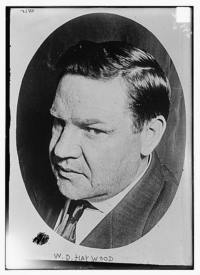 William D. Haywood (Big Bill). Photo of Big Bill Haywood taken sometime between 1910 and 1915. LC-DIG-ggbain-11283, Library of Congress Prints and Photographs Division. |
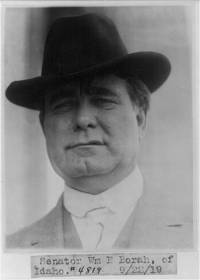 Senator William E. Borah. Senator William E. Borah, of Idaho was one of the prosecutors in the Haywood trial. "He was a hard worker, astute, and in every respect an able adversary. He was always wary and cautious and thoroughly familiar with his case." Clarence Darrow, The Story of My Life. LC-USZ62-39521, Library of Congress Prints and Photographs Division. |
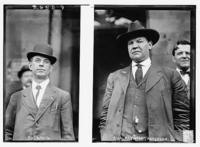 Adolph Lessig and Bill Haywood c.1913. Bill Haywood, as a leader of the Industrial Workers of the World (IWW), helped direct the Paterson Silk Strike of 1913 in Paterson, New Jersey. Adolph Lessig, who participated in the strike, was the business agent of the IWW. He participated in the strike. Taken in Paterson, New Jersey. Library of Congress Prints and Photographs Division, LC-DIG-ggbain-12728. |
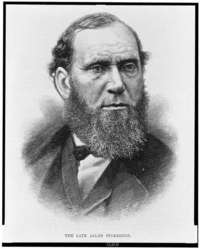 Allan Pinkerton. Allan Pinkerton (1819 - 1884) founded the Pinkerton National Detective Agency. He was born in Glasgow, Scotland in 1819 and emigrated to the United States in 1842. After arriving in the United States he setup a barrel-making shop in a small town outside of Chicago. Pinkerton was an abolitionist and he used his shop as a "station" for the Underground Railroad that helped escaped slaves gain passage to the North. Illustrated in Harper's Weekly, v. 28, 1884 July 12, p. 452. Library of Congress Prints and Photographs Division, LC-USZ62-117576. |
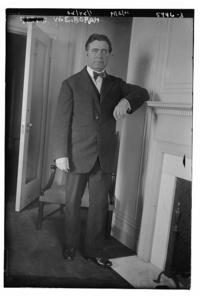 William E. Borah. The Haywood prosecution ran into trouble less than a month before the trial when William Borah, a newly elected Senator and special prosecutor for the trial, was indicted with several others over alleged land fraud involving timber. Borah was implicated because he worked as a lawyer for a lumber company under investigation. There appears to be considerable support for the view that these indictments were politically motivated. Borah, a progressive Republican compared to the conservative wing of the party, was gaining influence in the Republican Party and the party machine wanted to stop Borah. It is believed that the U.S. Attorney for Idaho, Norman M. Ruick, pushed the indictment of Borah at the urging of some politicians. Ruick had to pack the grand jury to almost double its normal size to get a majority of jurors to indict Borah. In addition, James Beatty, the retiring U.S. district judge, lobbied very hard for Borah''s indictment. Beatty was a frustrated Republican candidate for the Senate seat that Borah had just won. The trial greatly worried Borah but in the end the jury deliberated for only fourteen minutes before finding him not guilty. LC-DIG-ggbain-35617, Library of Congress Prints and Photographs Division. |
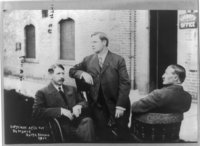 Bill Haywood - Charles Moyer - George Pettibone outside Boise, Idaho Sheriff's office awaiting trial for murder of ex-governor Frank Steunenberg. "In 1906 I was called upon by the Western Federation of Miners to defend Moyer, Haywood and Pettibone under an indictment charging them with the murder of ex-Governor Frank Steunenberg, of Idaho. This case had a most dramatic setting and attracted wide interest throughout America." Clarence Darrow, The Story of My Life. LC-USZ62-59678, Library of Congress Prints and Photographs Division. |
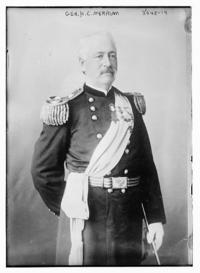 General Henry Clay Merriam. Brigadier General Henry Clay Merriam (1837 - 1912) led the military intervention to restore order in the Coeur d' Alenes area in 1899. The military intervention and other aspects of martial law, including the imprisonment of many miners in bullpens, led to the revenge assassination of the former governor of Idaho Frank Steunenberg in 1905. LC-DIG-ggbain-15949, Library of Congress Prints and Photographs Division. |
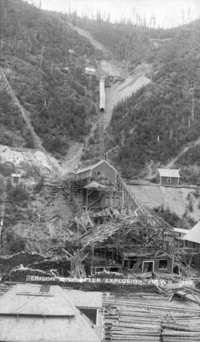 Frisco Mill after explosion Gem, Idaho. During the labor troubles in 1892 union miners battled mine owners and non-union workers at the Frisco mine on July 11. George Pettibone devised and implemented a plan to destroy the mill by sending dynamite down a penstock, a water flume that brought water into the mill. Western History/Genealogy Department, Denver Public Library. |
 Frank R. Gooding c. 1921. Frank Gooding, governor of Idaho from 1905 to 1909, took charge of the investigation into the assassination of former governor Frank Steunenberg. Library of Congress Prints and Photographs Division, LC-DIG-npcc-03381. |
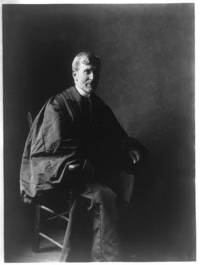 Joseph McKenna, Associate Justice, U. S. Supreme Court. Justice McKenna was the lone dissenter in Pettibone v. Nichols, 203 U.S. 192 (1906). McKenna wrote: "Kidnapping is a crime, pure and simple. It is difficult to accomplish; hazardous at every step. All of the officers of the law are supposed to be on guard against it. All of the officers of the law may be invoked against it. But how is it when the law becomes the kidnapper? When the officers of the law, using its forms, and exerting its power, become abductors?" Library of Congress Prints and Photographs Division, LC-USZ62-90085. |
 Big Bill Haywood. William Haywood was most often photographed with his face turned to hide the loss of his right eye. Haywood claimed he lost the eye at age nine when he punctured it with a knife while whittling a slingshot. |
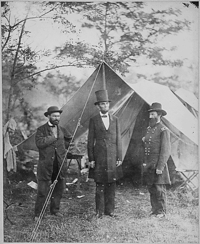 Allan Pinkerton, President Lincoln, and Major General John A. McClernand, Antietam, Maryland. Allan Pinkerton (1819 - 1884) created the Pinkerton National Detective Agency in 1850. He performed intelligence work for the Union during the Civil War. Photograph from the Battle of Antietam, September-October 1862. Library of Congress Prints and Photographs Division, LC-DIG-cwpb-04326. |
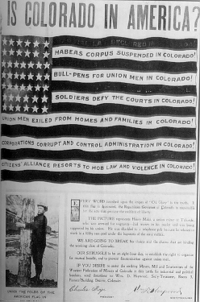 Is Colorado in America? Pamphlet designed by Bill Haywood and issued by the Western Federation of Miners (WFM). It depicts Henry Maki a union miner who had been chained to a telegraph pole during a strike in Telluride Colorado. Charles Moyer, president of the WFM, was arrested for desecrating the flag because of this pamphlet. It is signed by both Moyer and Haywood. |
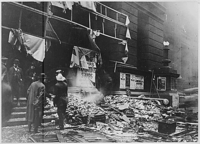 Wreckage of Chicago's Federal Building. Just after 3:00 p.m. on September 4, 1918 a very powerful bomb exploded in the Adams Street entrance of Chicago's Federal Building which contained a post office and a federal court. Four people were killed and dozens more were injured. It was widely believed that the bomb was planted by the Industrial Workers of the World (I.W.W.) in revenge for the conviction and sentencing of I.W.W. leader, "Big Bill" Haywood, and 94 other members for seditious activities. The courtroom where Judge Kenesaw Mountain Landis presided over the trial of Haywood and the other I.W.W. defendants was on the sixth floor of this building. Judge Landis had sentenced Haywood to 20 years in prison. Haywood was in this building on the 8th floor in the "cage room" of the United States Marshal's office when the bomb exploded. National Archives and Records Administration, ARC Identifier 533464. |
 Hugo Munsterberg. Hugo Munsterberg, Professor of Psychology at Harvard University, went to Idaho to examine Harry Orchard. He greatly angered Clarence Darrow when he later revealed to newspapers during the Haywood trial that he believed Orchard was telling the truth. He had promised the defense he would not reveal his opinion until after the trial. In 1907 he published an article titled "Experiments with a Multi-Murderer" in McClure's Magazine in which he describes his examination of Harry Orchard although he does not mention Orchard by name. Library of Congress Prints and Photographs Division, LC-DIG-ggbain-06890. |
 Hugo Munsterberg. A professor of psychology at Harvard University, Munsterberg was invited by McClure's Magazine to conduct a psychological study of Harry Orchard. In the course of a four hour meeting, Munsterberg became convinced that Orchard's confession was true. Contrary to a promise not to disclose his findings until after the trial, Munsterberg revealed his beliefs to a Boston Herald reporter and he gave an interview to another newspaper. The defense was infuriated not only because Munsterberg had promised to wait until the trial was over but they were afraid the sequestered jury would find out. McClure's Magazine claimed that it was Darrow himself who had suggested the hiring of a professional to study Orchard. Darrow and Richardson released a statement criticizing Munsterberg. Library of Congress Prints and Photographs Division, LC-DIG-ggbain-02822. |
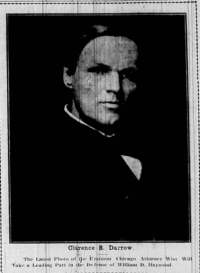 Clarence Darrow. Clarence Darrow's picture in the Idaho Daily Statesman which extensively covered the Haywood Trial. |
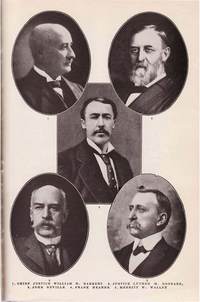 Individuals Harry Orchard Tried to Assassinate. Harry Orchard confessed to assassination attempts on each of these individuals, including Justice Gabbert, Chief Justice of the Supreme Court of Colorado and Justice Goddard, Associate Justice of the Supreme Court of Colorado. Orchard tried to assassinate Goddard the same way he assassinated Frank Steunenberg but the bomb failed to explode. Not pictured is former Chief Justice John Campbell. Frank Hearne, manager of the Colorado Fuel and Iron Company, had influenced the Supreme Court in certain decisions. Merrit Walley died in an explosion set for Judge Gabbert. |
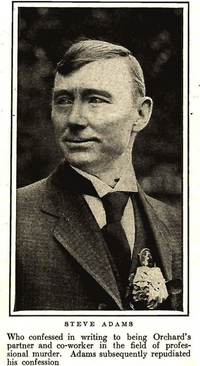 Steve Adams c. 1907. Harry Orchard accused Steve Adams, a WFM member, of participating in other violent crimes for the WFM. The prosecution needed Adams to corroborate Orchard's confession because Idaho law required corroboration of conspirators' confession. Adams was living in Oregon at the time and was later arrested. He was assured that he was only needed to corroborate Orchard's confession and he was taken to the Boise, Idaho penitentiary. McParland eventually got Adams to confess to some criminal activity which helped to corroborate at least some of Orchard's confession. Most importantly Adams confessed that he and Orchard had planted the explosives under the Independence depot which killed thirteen nonunion workers. One of Clarence Darrow's most significant early victories was getting an uncle of Adams's wife to persuade Steve Adams to repudiate his confession. |
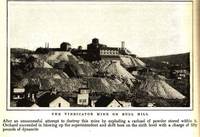 The Vindicator Mine on Bull Hill. Harry Orchard confessed to setting a bomb in the Vindicator Mine in Cripple Creek, Colorado in November of 1903. This was his first crime committed for the Western Federation of Miners and he was paid $500. The bombing killed two miners. Orchard had meant to kill some scabs in the mine but he placed the bomb on the wrong level. It was his work in the Cripple Creek area that brought Orchard to the attention of William Haywood and other WFM leaders. |
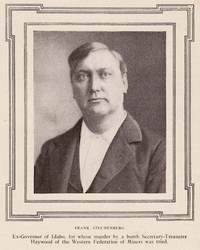 Frank Steunenberg. Frank Steunenberg was the fourth Governor of the State of Idaho, serving from 1897 until 1901. He was assassinated December 30, 1905. His good friend William E. Borah said of him: "Frank Steunenberg was of the rarest type of manhood. Open, sincere, modest and unassuming, he was in his purposes and plans as inflexible as honor itself. Rugged in body, resolute in mind, almost massive in the strength of his convictions, he was of the granite hewn." Funeral address given on January 3, 1906, Caldwell, Idaho. |
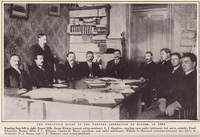 Executive Board of the Western Federation of Miners. Photo includes Charles Moyer and William Haywood. L.J. (Jack) Simpkins is standing. |
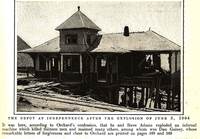 Depot at Independence. On June 5, 1904 Harry Orchard and Steve Adams set off an explosion at the Independence Depot killing thirteen non-union men and maiming several more. |
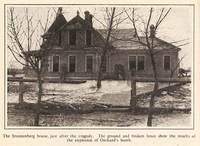 Home of Frank Steunenberg after the explosion that killed him. This photo shows the left gate post and several feet of the gate were destroyed by the bomb. |
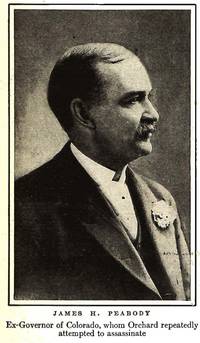 James H. Peabody. Harry Orchard confessed to several attempts to assassinate Ex-Governor James Peabody of Colorado. The labor conflict in Colorado was even more violent than in Idaho. |
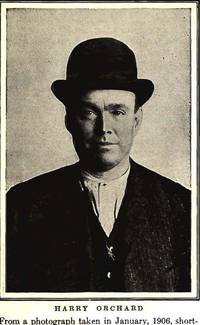 Harry Orchard. Throughout his eleven hour closing argument, Clarence Darrow continually vilified Harry Orchard, the main witness against Haywood. At various times Darrow referred to Orchard as: a monster, a phenomenal murder, a perjured monster, a monstrous liar, a man who was bred to cheat and lie, a liar, an unstinted liar, a sneaking, craven coward, a characterless man, shifty Harry, despicable, crooked brain and his crooked, dwarfed soul, totally depraved, this miserable wretch, and at least the biggest liar that this generation has ever known. Haywood said Darrow's attacks "tore the degenerate Orchard to fragments..." |
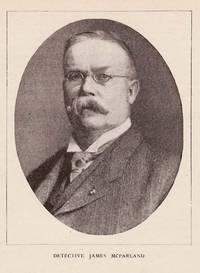 Detective James McParland. The Pinkerton Detective agent who succeeded in getting Harry Orchard to confess to assassinating Frank Steunenberg and committing numerous other crimes on behalf of the Western Federation of Miners. |
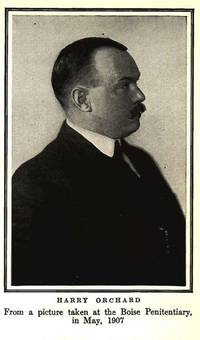 Harry Orchard. |
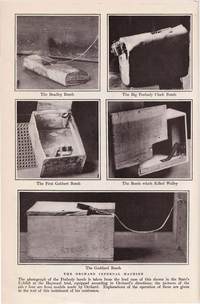 The Orchard Infernal Machine. Various bombs constructed by Harry Orchard. |
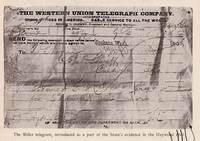 Miller telegram. Telegram from Fred Miller, an attorney working for the Western Federation of Miners, to "T. Hogan" (a.k.a. Harry Orchard) informing him that Miller "will start for Caldwell in the morning." It was sent on January 3, 1906, just days after the murder of Frank Steunenberg. The prosecution introduced into evidence to show a connection between Harry Orchard and the Western Federation of Miners. Miller later worked on the defense team during the Haywood trial. |
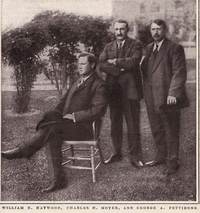 William D. Haywood, Charles H. Moyer, and George A. Pettibone. Big Bill Haywood was much more radical than Charles Moyer who preferred negotiations with mine owners instead of violence. Pettibone also did not agree with Haywood. The animosity between them increased during the more than sixteen months they were confined waiting for Haywood's trial. By December 1906, Moyer and Pettibone were not on speaking terms with Haywood. |
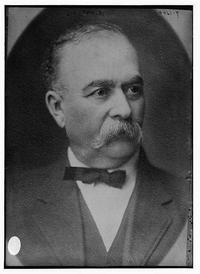 James H. Hawley. Although Clarence Darrow ridiculed and goaded Hawley during the Haywood trial, Darrow was kinder to Hawley in his 1932 autobiography: "an old typical pioneer lawyer of the West, a man of ability, long a resident of the State, and had for many years been connected with most of the important litigation of Idaho. He had held various political offices, and soon after the trial was elected governor." Story of My Life 143-44 (1932). Library of Congress Prints and Photographs Division, LC-DIG-ggbain-26037. |
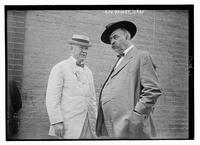 James H. Hawley, Governor of Idaho. James H. Hawley was a member of the prosecution during the Haywood trial. He served as mayor of Boise from 1903 to 1905 and Governor of Idaho from 1911 until 1913. Hawley was born in Dubuque, Iowa in 1847 and died August 3, 1929, in Boise, Idaho. Library of Congress Prints and Photographs Division. |
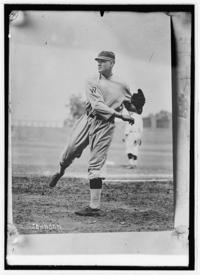 Walter Johnson. A Major League baseball pitcher from 1907 to 1927, Walter Perry Johnson is considered one of the greatest pitchers in the history of baseball. During the Haywood trial, Johnson was a 20-year-old pitcher playing his second season with the semi-professional Weiser Kids located about 75 miles from Boise. When the Weiser Kids traveled to Caldwell to play their semi-pro team on June 30, 1907 the game rivaled the Haywood trial for interest. In August 1907 Johnson began his professional career with the Washington Senators. Library of Congress Prints and Photographs Division LC-DIG-npcc-19194. |
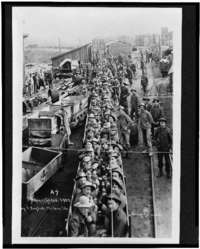 Going to Work. Men in open railroad cars on their way to the mines. Library of Congress, LC-USZ62-107002. |
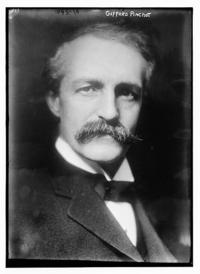 Gifford Pinchot. Gifford Pinchot (1865 - 1946) was the first Chief of the United States Forest Service from 1905 to 1910. He later served as Governor of Pennsylvania from 1923 to 1927 and 1931 to 1935. Pinchot, as part of the Theodore Roosevelt administration, consolidated power in the Forest Service much to the dismay of timber interests in the West, including Idaho where large tracts of land were designated as national forests by 1907. The Roosevelt administration started pressing timber fraud prosecutions which resulted in William Borah being indicted for timber fraud at the same time he was serving as one of the prosecutors in the Big Bill Haywood trial. Pinchot attended some of the Haywood trial and he faced political pressure to back off the prosecution of Borah until after the Haywood trial. Borah was ultimately acquitted. Library of Congress Prints and Photographs Division, LC-DIG-ggbain-04976. |
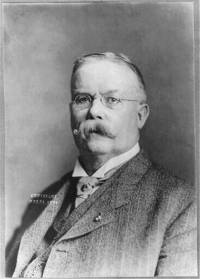 James McParland c. 1907. James McParland was the lead Pinkerton detective during the investigation of the assassination of Frank Steunenberg. During Steve Adams' first murder trial, Clarence Darrow told the jury during his closing argument: "This McParland, what is his trade? Is there any worse trade than the one that man follows? ... can you believe a detective at all? What is he? A detective is not a liar, he is a living lie. His whole profession is that, openly and notoriously." Library of Congress Prints and Photographs Division, LC-USZ62-73991. |
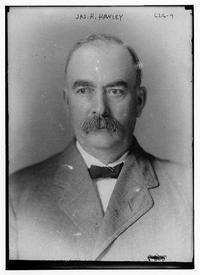 James H. Hawley. Part of Clarence Darrow's defense strategy was to attack and frustrate James Hawley, one of the lead prosecutors: "Hawley's exasperation was precisely what Darrow had sought. Behind it was his deliberative strategy, evident in virtually all his trials, of selecting one of the prosecution's attorneys as a scapegoat against whom to employ his considerable weapons of scorn and sarcasm. So venomous were Darrow's sallies against the verbose and syntactically muddled Hawley, so wounding were they to the attorney's pride, that Hawley's twenty-five-year-old son, Jess, . . . occasionally threatened—out of court—to punch Darrow in the nose if he didn't cease and desist. J. Anthony Lukas, Big Trouble: A Murder in a Small Western Town Sets Off a Struggle for the Soul of America (1998). Library of Congress Prints and Photographs Division, LC-DIG-ggbain-37237. |
 Boise, Idaho c. 1909. Library of Congress Prints and Photographs Division, LC-USZ62-130866. |
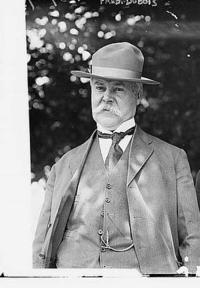 Senator Fred T. Dubois. Fred T. Dubois served as an Idaho Senator from 1891 to 1897, and 1901 to 1907. He began his career as a Republican but later changed to the Democratic party. Dubois was a political rival of Frank Steunenberg. He was best-known for his opposition to the gold standard and his work to disenfranchise Mormon voters. Library of Congress Prints and Photographs Division, LC-DIG-ggbain-07892. |
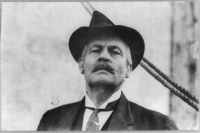 Walter Wellman, 1858-1934. Walter Wellman was an American journalist and explorer. Library of Congress Prints and Photographs Division, LC-USZ62-53468. |
 Boise, Idaho c. 1909. Library of Congress Prints and Photographs Division, Call Number: PAN US GEOG - Idaho no. 32 (E size) [P&P]. |
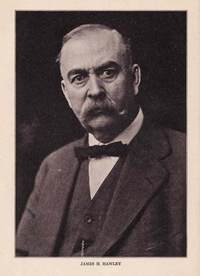 James H. Hawley. James Hawley was one of the two main prosecutors in the Haywood trial. He served as mayor of Boise, Idaho from 1903 to 1905 and Governor of Idaho from 1911 until 1913. |
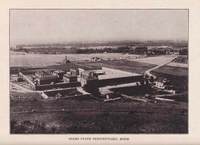 Idaho State Penitentiary, Boise. Harry Orchard and Steve Adams were held here. |
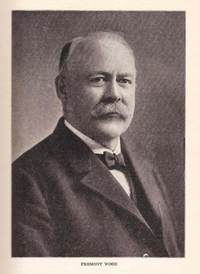 Judge Fremont Wood. Judge Wood presided over the Haywood trial. According to a book about the trial: "Judge Wood . . . was not a popular man in Boise or in Idaho after the trial. He faced not only vilification by Governor Gooding, but the slander of widespread rumors that he had been bribed. He remained a district judge to conduct the Pettibone and Orchard trials, but left the bench shortly thereafter with his career virtually ruined. Public opinion in Idaho did not forgive or forget Wood's instructions to the Haywood jury, particularly after it became known that he believed that Orchard was telling the truth and that Haywood was guilty." David H. Grover, Debaters And Dynamiters: The Story of The Haywood Trial 291 (1964). |
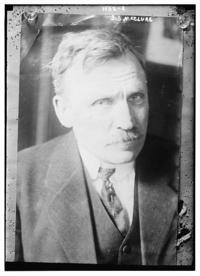 S.S. McClure. Hugo Munsterberg, a professor of psychology at Harvard University, was invited by S.S. McClure of McClure's Magazine to conduct a psychological study of Harry Orchard. Munsterberg was a protege of William James and after James was the most well known psychologist in the United States. After returning to the East Coast Munsterberg unwittingly disclosed his conclusions that Orchard was being truthful to a Boston Herald reporter and this was promptly reported in the paper. The defense was infuriated not only because Munsterberg had promised to wait until the trial was over to speak, but because they were afraid the sequestered jury would learn of the news. McClure's claimed that it was Darrow himself who had suggested hiring a professional to study Orchard. Library of Congress Prints and Photographs Division, LC-DIG-ggbain-05453. |
 Boise, Idaho c. 1907. Clarence Darrow wrote in his autobiography, The Story of My Life: "Until entering this case I had never been in Boise. I had read of it, and knew that it was far away out West. I had pictured it to myself, but I never found an unfamiliar person or place that proved to be anything like my mental picture. Boise was approached from the east through hundreds of miles of dreary, dusty desert with no living thing in sight but gophers and sage-brush. During the trip one deliberates whether to keep the car-window tightly closed and die for want of air or raise it ever so little and be suffocated with the clouds of powdered alkali. I always did both, one after the other. Through the whole region of desert waste, a long strip of green wound and twisted its tortuous way in loops and zigzags across the desolate plain. This is the Snake River, named from the animal which Adam had in mind when he named Eve's tempter. As we neared Boise the scene changed. The fields were fresh and green, the orchards were luxuriant, the town resplendent with lawns and flowers, shrubs and trees; the houses were neat and up-to-date. The Snake River had been intersected with dikes, which irrigated the barren wilderness and made it a beautiful garden-spot. The landscape was most pleasing, and out beyond, a circle of mountains enclosed the little city; so that after the long, wearisome journey Boise seemed like a bright green gem in a setting of blue. It is the capital of the State, with attractive public and private buildings, and a good library. Except for the hard work, intense worry and suffering, and the bitter opposition, it was a pleasant place to visit. Boise had a pride in its town and people and culture, and could rightly be called the Athens of the sage-brush." Library of Congress Prints and Photographs Division, LC-USZ62-130243. |
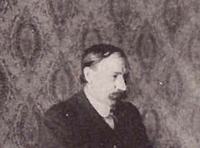 L. J. Simpkins Harry Orchard implicated Western Federation of Miners executive board member Jack Simpkins in the murder of Steunenberg. Simpkins disappeared after Haywood and the others were arrested and he remained a mysterious figure. Despite the efforts of both the Pinkerton and Thiel detective agencies and a $2,000 reward from the State of Idaho, he was never found. Simpkins’ disappearance was the subject of numerous rumors: “Simpkins was dead, killed by the WFM to ensure he never informed on his co-conspirators; Simpkins had found sanctuary in Australia or Singapore; Simpkins was a Pinkerton plant, an agent provocateur sent my McParland to trigger the Steunenberg assassination as a means to exterminate the WFM’s leaders.” J. Anthony Lukas, Big Trouble: A Murder in a Small Western Town Sets Off a Struggle for the Soul of America 293 (1998). |
 Nampa, Idaho c. 1907. Bill Haywood, Charles Moyer, and George Pettibone were secretly taken by train to Idaho to avoid any rescue attempt by labor sympathizers. The train stopped in Nampa to pickup Canyon County Sheriff Jasper Nichols and County Attorney Owen Van Duyn before the final stretch to Boise. This was an attempt to make it look like local officials helped bring the defendants to stand trial. Nampa is about 20 miles west of Boise. Library of Congress Prints and Photographs Division, pan 6a03730 http://hdl.loc.gov/loc.pnp/pan.6a03730 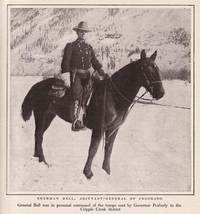 General Sherman Bell. Sherman M. Bell, a mine manager, was appointed adjutant-general of the Colorado National Guard and commanded troops sent by Governor Peabody to the Cripple Creek district during the labor war in 1903-04. A former Rough Rider under Teddy Roosevelt, Bell aggressively battled the Western Federation of Miners in Colorado without worrying about protecting the legal rights of the miners. Bell was quoted as saying, "Military necessity recognizes no laws, either civil or social." J. Anthony Lukas, Big Trouble: A Murder in a Small Western Town Sets Off a Struggle for the Soul of America 225 (1998). 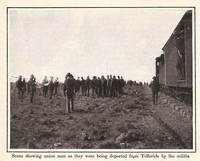 Union Men being deported from Telluride, Colorado by militia c. 1904. Photo from "Introductory Note to the Confession and Autobiography of Harry Orchard" published in McClure's Magazine in 1907. 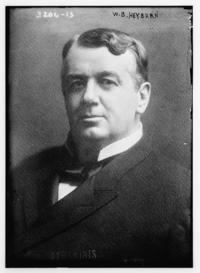 Weldon B. Heyburn. Weldon Brinton Heyburn (1852 - 1912) was a U.S. Senator from Idaho from 1903 to 1912. In 1902 Heyburn was elected by the Idaho Legislature to the United States Senate in a stunning defeat for Boise attorney William Borah. Money had been paid to sway the vote which initially Borah was winning. Library of Congress Prints and Photographs Division, LC-DIG-ggbain-17013. | |||
 Caldwell, Idaho c. 1907. The intersection of Seventh and Main can be seen in the center of this photograph. To the left is Frank Steunenberg's Caldwell Banking and Trust Company. On the right is the Saratoga Hotel, where Harry Orchard had registered under the name of "Thomas Hogan." After his arrest, bomb making material was found in Orchard's room at the Saratoga. Library of Congress Prints and Photographs Division, LC-USZ62-130241. |
 Goldfield, Nevada. Vincent St. John was shot in Goldfield, Nevada by a "conservative" in the Western Federation of Miners. The two bullets in his right wrist shattered the bone, crippling his hand. |
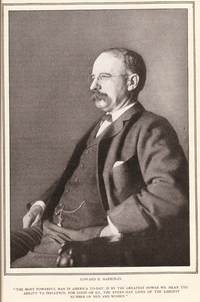 Edward H. Harriman (1848-1909). In a letter, President Theodore Roosevelt said Harriman was "at least as undesirable a citizen as Debs, or Moyer, or Haywood." Labor seized on this incident, condemning Roosevelt for publicly criticizing two men on trial who would be executed if convicted. Harriman was one of the most powerful railroad executives in the country. At his death, he controlled several railroads: the Union Pacific, Southern Pacific, Saint Joseph and Grand Island, Illinois Central, Central of Georgia, Pacific Mail Steamship Company, and the Wells Fargo Express. |
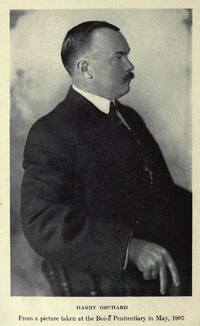 Harry Orchard. Harry Orchard's well-groomed appearance during the trial was in sharp contrast to how he looked when arrested and the expectations viewers had when they heard about the numerous murders he confessed to. |
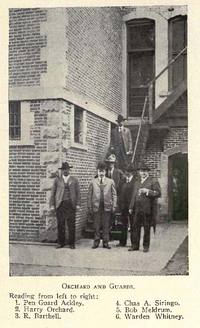 Harry Orchard and guards. |
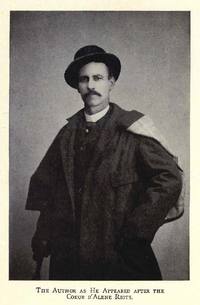 Charles Angelo Siringo. Charles Angelo Siringo (1855 - 1928), was lawman, famous detective for the Pinkerton National Detective Agency and writer. Leading up to the labor troubles of 1892 in the Coeur d'Alene area, mine owners had employed undercover detectives or spies to gain intelligence because the mine owners and non-union miners were outnumbered by hostile union miners. Working undercover, Siringo infiltrated and became one of its most trusted union men in the Gem union. Siringo focused his espionage on George Pettibone, the union’s financial secretary. Each day Siringo mailed a handwritten report to the Pinkerton office in St. Paul, Minnesota and the information allowed the mine owners to stay ahead of the miners. Siringo’s identity as a spy was made known to the union miners on July 9, 1892. The realization that the mine owners had planted a spy in the union camp has been identified as one of the primary causes of the violence that followed on July 11, when union miners battled mine owners and non-union miners at the Frisco Mill and Gem Mine. After his identity was revealed, the union tried to capture or kill Siringo. Siringo, aware that his life was in danger, decided during the fight at Gem Mine to make his escape. He dropped down a hole under the floorboards of a house and crawled under the boardwalk of the main street in Gem while union men walked above. He later escaped to safety, which only intensified the miners’ anger. |
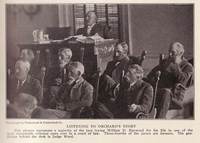 Jury listening to Harry Orchard's story. Several jurors and Judge Wood are visible in this photo. |
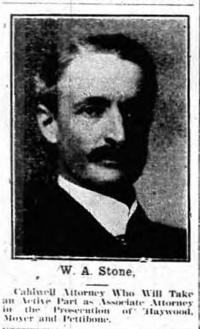 William A. Stone. William A. Stone was one of the prosecutors in the Haywood trial. |
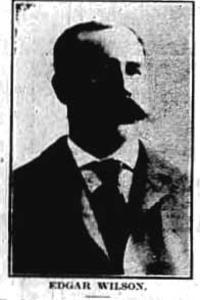 Edgar Wilson. Edgar Wilson was a former law partner of Judge Fremont Wood for 11 years and a leading Boise citizen. Darrow succeeded in getting Wilson to assist the defense, much to the surprise of many Boise residents. Clarence Darrow wrote in his autobiography: "We had already become rather well acquainted with Mr. and Mrs. Edgar Wilson. Mr. Wilson was the first Congressman from Idaho, one of the earliest settlers of the State, and one of the most respected. Then, and afterward, the Wilsons were our loyal friends, and did a great deal to make life more tolerable in Idaho; and later on, in Los Angeles, they proved as staunch and devoted as any friends that ever came into our lives." |
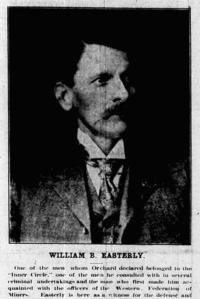 William B. Easterly. Harry Orchard claimed that William Easterly belonged to the inner circle of the union leaders. Easterly denied Orchard's allegations and was a witness for the defense. |
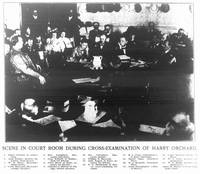 Scene in Court Room During Cross-Examination of Harry Orchard. Harry Orchard is in the witness chair at the left. Clarence Darrow is to the right with his hand on his chin. |
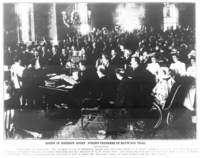 Courtroom Scene during Haywood Trial. |
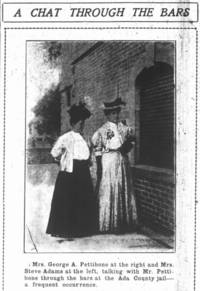 Mrs. George A. Pettibone and Mrs. Steve Adams. Photo from the Idaho Daily Statesman. |
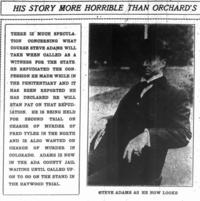 Steve Adams. Newspaper speculation about whether Steve Adams will reconsider his repudiation of his confession. The prosecution had to have Steve Adams confession to corroborate Harry Orchard's confession. |
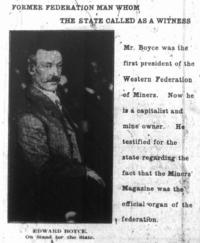 Ed Boyce. Edward Boyce was a founder and the first president of the Western Federation of Miners. Born in County Donegal, Ireland, he came to the United States at age 19. |
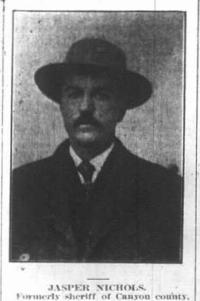 Jasper Nichols. Jasper Nichols was the sheriff of Canyon County, Idaho. George Pettibone filed a writ of habeas corpus, alleging that he was unlawfully held by Sheriff Nichols in violation of the Constitution and laws of the United States. Pettibone's case went to the United States Supreme Court - Pettibone v. Nichols, 203 U.S. 192 (1906). |
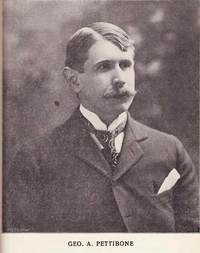 George A. Pettibone. The code name used by the Pinkerton Detective Agency to identify Pettibone was "Rattler." |
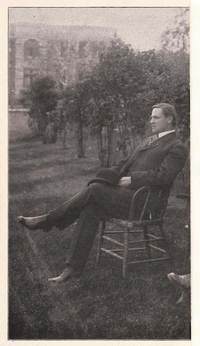 Big Bill Haywood. Although he was facing a capital murder trial, Haywood recounted in his autobiography, "A part of the time I spent in the Ada County jail was the most quiet, peaceful period of my life. I have never enjoyed myself better than the first few months I was there. It was my first real opportunity to read." The Autobiography of Big Bill Haywood 198 (1966). |
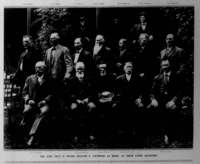 Jury in the Haywood Trial. The jury consisted of nine farmers, a real estate agent, an ex-carpenter and a foreman of a fence-building operation. There were eight Republicans, three Democrats and one Prohibitionist; nine were born in the United States, two in Scotland and one in Canada. |
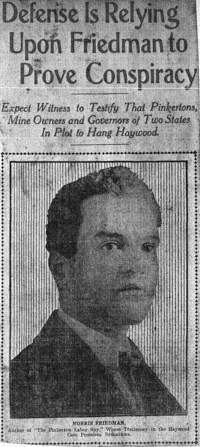 Morris Friedman. Friedman, who formerly worked as a clerk and stenographer for the Pinkerton Detective Agency, testified for the defense. He published a book called The Pinkerton Labor Spy, in which he detailed how the Pinkertons infiltrated labor unions. |
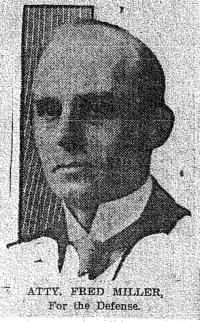 Fred Miller. Miller was one of Haywood's defense attorneys. |
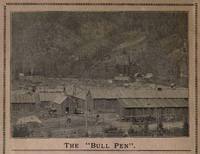 The temporary prison used to house miners arrested during martial law. The "bullpens" would become notorious among union members and serve as a primary example of the violation of constitutional rights. |
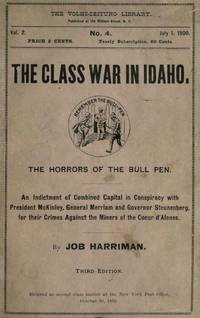 Class War in Idaho: The Horrors of the Bull Pen. Cover from pamphlet written by Job Harriman. The term "bull pen" became fighting words to the miners. Harriman later played a prominent role as co-counsel with Clarence Darrow in the McNamara case. |
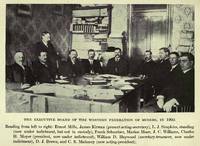 Executive Board of the Western Federation of Miners, 1905. Photo includes Charles Moyer and William Haywood. The mysterious L.J. (Jack) Simpkins is standing. |
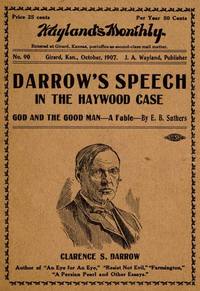 Cover from pamphlet featuring Clarence Darrow's Closing Argument. Several of Clarence Darrow's closing arguments in his most famous cases were published in pamphlet form, available for purchase. |
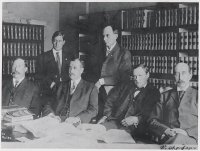 Haywood's Defense Team. Left to right: Edgar Wilson of Boise, Leon Whitesell of Wallace, John F. Nugent of Boise, Fred Miller of Spokane, Clarence Darrow of Chicago and Edmund F. Richardson of Denver in Boise. May 11, 1907. Courtesy of McCormick Library of Special Collections, Northwestern University Library. |
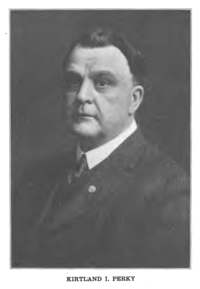 Kirtland I. Perky. Kirtland Perky (1867 - 1939) was a United States Senator from Idaho and an Idaho state judge. While suffering from mastoiditis, Clarence Darrow recuperated for a time at Judge Perky's home during part of the Pettibone trial. Judge Perky also assisted Darrow during the trial including jury selection. In 1912, Perky, a Democrat, was appointed to the United States Senate by Governor James H. Hawley to fill the vacancy caused by the death of Weldon B. Heyburn. |
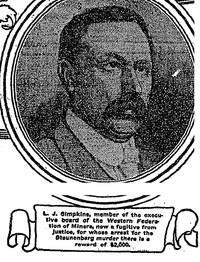 L.J. "Jack" Simpkins. Drawing of L.J. Simpkins from the New York Times. |
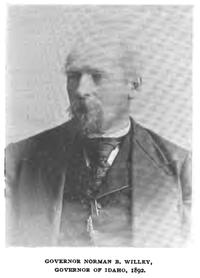 Governor Norman B. Willey. Norman B. Willey was Governor of Idaho during the labor troubles of 1892 in the Coeur d'Alene area. |
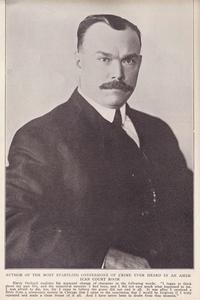 Harry Orchard. "AUTHOR OF THE MOST STARTLING CONFESSIONS OF CRIME EVER HEARD IN AN AMERICAN COURT ROOM." |
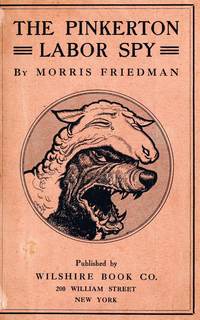 The Pinkerton Labor Spy by Morris Friedman. Cover from book written prior to the trial by Friedman who had previously worked as a stenographer for the Pinkerton Detective Agency. Friedman testified for the defense about the tactics the agency used to infiltrate labor unions. Full text available above. |
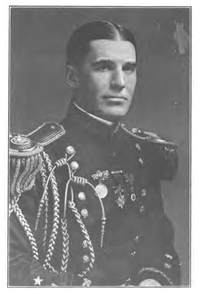 Sherman M. Bell, Adjutant-General of Colorado. Bell, a mine manager, was appointed adjutant-general of the Colorado National Guard and commanded troops sent by Governor Peabody to the Cripple Creek district during the labor war in 1903-04. Bell was a former Rough Rider under Teddy Roosevelt. |
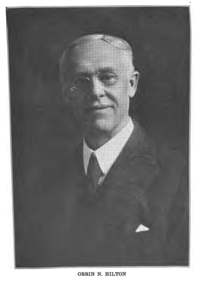 Orrin N. Hilton. Orrin Hilton defended Steve Adams against murder charges in Colorado after the Haywood, Pettibone and Adams murder trials in Idaho were over. |
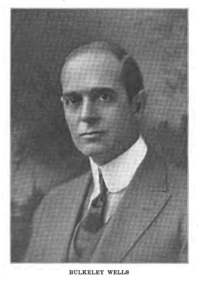 Bulkeley Wells. Bulkeley Wells managed the Smuggler-Union, the largest and richest gold mine in Telluride, Colorado. He also served as Adjutant General of the Colorado National Guard from 1905 to 1907 and as a colonel from 1907 until 1909. Wells led the fight in the Telluride area against the Western Federation of Miners. In 1908 a bomb destroyed Wells' Telluride home, but Wells survived. The assassination attempt was believed to be the work of the WFM. Wells had particular animosity for Vincent St. John (1876 - 1929), an American labor leader and a prominent leader of the Industrial Workers of the World (I.W.W.). Clarence Darrow defended Vincent St. John in 1918 when about 100 I.W.W. members including William D. Haywood were arrested, tried and convicted of disloyal acts against the government. Haywood was sentenced to 20 years in prison and St. John was sentenced to 10 years. Photo from History of Colorado,, edited by Wilbur Fiske Stone (1918). 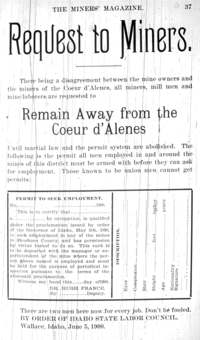 Protest Against Permit System. During the labor troubles in 1899, a permit system was instituted by Bartlett Sinclair, the state auditor for Idaho who represented Governor Steunenberg. The permit system required miners to get a permit from the sheriff showing each was law abiding and not a member of any organization that had engaged in violence in the area. The federal military commander, Brigadier-General Merriam, signed off on the proclamation, thus giving federal backing to the permit system. The proclamation did not actually name the WFM or the Miners Union of the Coeur d'Alenes, but it was clearly drafted to break the WFM. 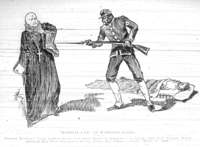 "Martial Law" at Wardner, Idaho. Caption reads: "Martial Law" at Wardner, Idaho General Merriam's Negro Soldiers Refused to Allow Priests to Administer to Dying "Bull Pen" Victims. Where Innocent Men were Tortured to Death. From the Atlanta Journal. March 17, 1900." During the 1899 Coeur d'Alene labor troubles, one of the main reasons the miners and their sympathizers deeply resented the imposition of military rule was the participation of the Twenty-fourth Infantry Regiment, a highly regarded unit with black troops under the command of white officers. During his testimony on the stand in his murder trial, William Haywood said "I was opposed to outrages that were perpetrated against the women there by the negro soldiers." | ||
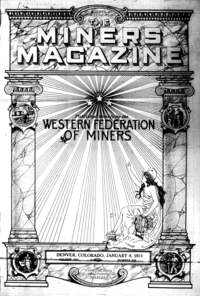 Miners' Magazine. The Miners' Magazine was published by the Western Federation of Miners (WFM). During the Haywood trial the prosecution read into evidence excerpts from the magazine that were very critical of Stuenenberg to show that the WFM hated the former governor. This cover is from 1914. |
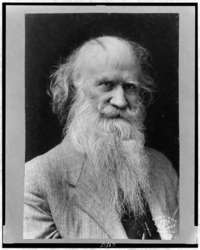 Joaquin Miller c. 1906. Joaquin Miller was the pen name of an eccentric American poet and essayist named Cincinnatus Heine (or Hiner) Miller. He was often referred to as "The Poet of the Sierras." Miller was an ardent self promoter and has been accused of fabricating much of his life story. The document above titled "The Poet of the Sierras" describes an encounter between Miller and Clarence Darrow after the Haywood trial as told by their mutual friend Elbert Hubbard. Miller's birthdate is not certain and has been listed as September 8, 1837, or March 10, 1841, or November 10, 1841. He died on February 17, 1913. Library of Congress Prints and Photographs Division, LC-USZ62-119515. |
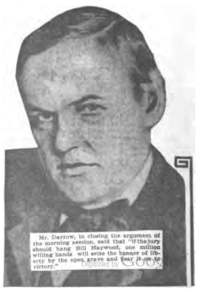 Clarence Darrow. "Mr. Darrow, in closing the argument of the morning session, said that, 'If the jury should hang Bill Haywood, one million willing hands will seize the banner of liberty by the open grave and bear it on to victory.'" This photo and caption are taken from an article about press misrepresentations; the article used a misrepresentation of Clarence Darrow's words during the Haywood trial as an example. Published in The Arena. |
 Pinkerton's National Detective Agency ad. Pinkerton's National Detective Agency was private security guard and detective agency established in the United States by Allan Pinkerton in 1850. Their early logo with an eye and the claim "We Never Sleep" was the origin of the term "private eye." Image from the Library of Congress. |
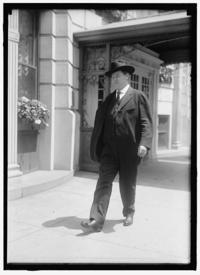 William D Haywood. Big Bill Haywood was one of the most radical and feared labor leaders in the United States. Haywood was ousted from leadership in the Western Federation of Miners in 1908. He went on to leadership roles in the International Workers of the World (IWW) and helped textile workers lead strikes in Lawrence, Massachusetts and Paterson, New Jersey. In 1918 Haywood was convicted along with about a hundred other defendants, including IWW leaders, in a conspiracy to undermine the war efforts of the United States. He spent a year at Leavenworth prison and was released while his appeal was pending. Haywood defected to the Soviet Union in 1921 and lived in Moscow until he died in 1928. Haywood was cremated and half of his ashes were buried under the Kremlin Wall and half were buried near a monument for the Haymarket anarchists in Chicago. Library of Congress Prints and Photographs Division, LC-DIG-hec-05936. |
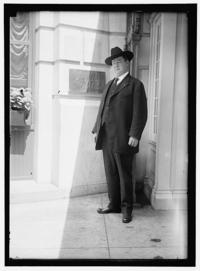 Big Bill Haywood. Haywood's narrow escape from the gallows in 1907 did not persuade him to give up radical labor politics. In 1908 he was ousted from the Western Federation of Miners leadership. In 1915 Haywood became the official leader of the Industrial Workers of the World (I.W.W.) the same organization he help found in 1905. Library of Congress Prints and Photographs Division, LC-DIG-hec-07493. |
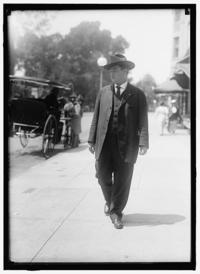 Library of Congress Prints and Photographs Division, LC-DIG-hec-05935. |
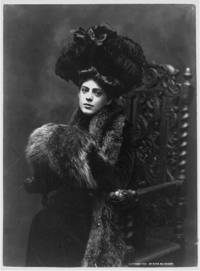 Ethel Barrymore c. 1901 Ethel Barrymore watched Clarence Darrow's opening of the defense case but she was a little distrustful: "He had all the props: an old mother in a wheelchair and a little girl with curls draped around Haywood" and she even wondered whether the little girl was Haywood's daughter. J. Anthony Lucas, Big Trouble: A Murder in a Small Western Town Sets Off a Struggle for the Soul of America 570 (1998). Library of Congress Prints and Photographs Division, LC-USZ62-97334. |
 Ethel Barrymore c. 1901. Ethel Barrymore, one of the most famous actresses at the time, came to Boise on June 24, 1907 to star in "Captain Jinks and the Horse Marines." She visited the courtroom during the trial, upstaging Clarence Darrow as he was opening for the defense. Library of Congress Prints and Photographs Division, LC-USZ62-44297. |
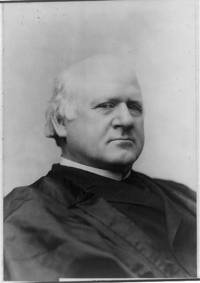 John Marshall Harlan c. 1890. Justice Harlan (1833 - 1911) was an Associate Justice of the United States Supreme Court from 1877 to 1911. Harlan wrote the majority opinion in Pettibone v. Nichols, 203 U.S. 192 (1906). The Court ruled that a person held in actual custody by a state for trial in one of its courts under an indictment for a crime against its laws will not be released on habeas corpus by a federal Circuit Court even though the methods by which his personal presence in the state was secured may have violated the provisions of United States Constitution. James Hawley, one of the two main prosecutors in the case, later confided to the Pinkerton Detective James McParland that in October 1906, before the Court heard oral arguments in the case, he met with his friend Justice Harlan. Hawley told Harlan about facts of the case that Hawley thought might have "a good effect" according to J. Anthony Lukas in Big Trouble: A Murder in a Small Western Town Sets Off a Struggle for the Soul of America. Lukas believed that this ex parte meeting may have influenced Harlan's decision especially if Hawley provided details of Harry Orchard's confession. Library of Congress Prints and Photographs Division, LC-USZ62-40292. |
 William A. Pinkerton with Railroad Special Agents Pat Connell (left) and Sam Finley (right). William Allan Pinkerton (1846 - 1923) was the son and oldest child of Allan Pinkerton the founder of the Pinkerton Detective Agency. William along with his brother Robert took over the Pinkerton Detective agency after their father's health declined. Library of Congress Prints and Photographs Division, LC-DIG-ppmsca-10781. |
 Walter Johnson, Washington Americans c. March 1911. During the Haywood trial, Walter Johnson was a twenty-year-old pitcher for a minor league team in Weiser, about seventy-five miles Northwest of Boise. He was such a phenomenal player, that when Weiser played Caldwell, the game rivaled the Haywood trial in terms of public interest. Johnson later became one of the best pitchers in baseball history. Library of Congress Prints and Photographs Division, LC-DIG-ppmsca-18320. |
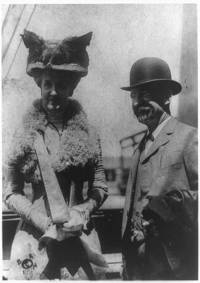 Edward Henry Harriman, Railroad Magnate, and Wife. Edward Harriman was one of most powerful railroad magnates in the country. President Theodore Roosevelt had been having a dispute with Harriman and he angrily released a letter to the press in which he said Harriman was "at least as undesirable a citizen as Debs, or Moyer, or Haywood." Labor seized on this incident, condemning Roosevelt for publicly criticizing two men on trial who would be executed if convicted. Before Roosevelt released the letter to the press he read parts of the letter to members of the United States Supreme Court during the traditional meeting with the president just prior to the start of the fall term of the Court. At this time, the Court had on its schedule three days later the oral arguments in the case of Pettibone v. Nichols, the appeal from the Idaho Supreme Court and federal district courts which had denied Haywood, Pettibone and Moyer habeas corpus relief from their removal to Idaho. Library of Congress Prints and Photographs Division, LC-USZ62-97597. |
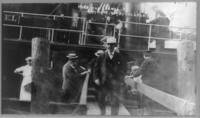 Edward Henry Harriman. Library of Congress Prints and Photographs Division, LC-USZ62-97598. |
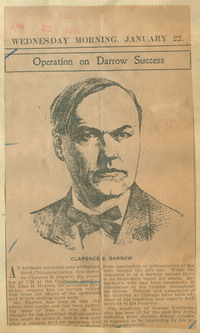 Operation on Darrow Success. A Los Angeles Herald article dated January 22, 1908 reports that Clarence Darrow successfully underwent surgery at a California hospital in Los Angeles. Dr. Walter Lindley Scrapbooks, Special Collections, Libraries of the Claremont Colleges, Claremont, CA. |
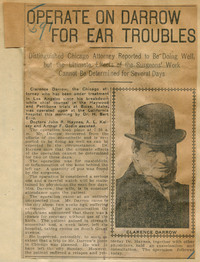 Operate on Darrow for Ear Troubles. News article from an unknown source reporting that Clarence Darrow has undergone surgery for mastoiditis at the California hospital in Los Angeles. Dr. Walter Lindley Scrapbooks, Special Collections, Libraries of the Claremont Colleges, Claremont, CA. |
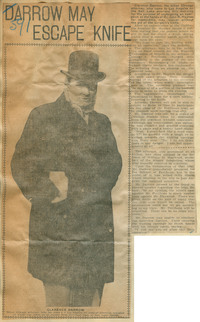 Darrow May Escape Knife. News article from unknown source about Clarence Darrow going to Los Angeles to consult a doctor about a serious illness with his ear. Dr. Walter Lindley Scrapbooks, Special Collections, Libraries of the Claremont Colleges, Claremont, CA. |
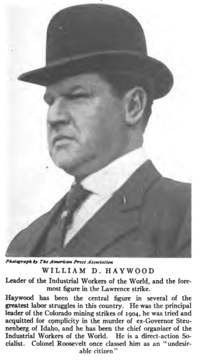 William D. Haywood. Photo from an article about the 1912 Lawrence Textile Strike in Lawrence, Massachusetts. The strike by immigrant workers was led by the Industrial Workers of the World. Photo from The American Magazine (1912). |
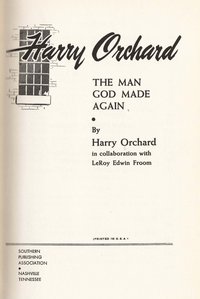 Harry Orchard, The Man God Made Again. Title page from a book Harry Orchard co-wrote and published in 1952. He co-wrote the book with LeRoy Edwin Froom (1890 - 1974) a Seventh-day Adventist minister, historian, and secretary of the General Conference Ministerial Association. Harry Orchard lived as a trustee in the Idaho penitentiary, raising chickens and strawberries. Orchard's religious conversion appears to have been genuine. He became a devout Seventh Day Adventist and he was a trusted and well-liked prisoner for the rest of his life. |
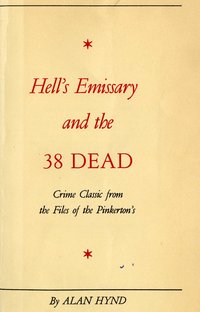 Hell's Emissary and the 38 Dead. Cover from pamphlet about Harry Orchard published in 1941. |
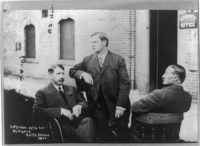 George Pettibone, Bill Haywood, Charles Moyer. The three defendants outside of the Boise, Idaho Sheriff's office awaiting trial for murder of ex-governor Frank Steunenberg. Library of Congress Prints and Photographs Division , LC-USZ62-59678. |
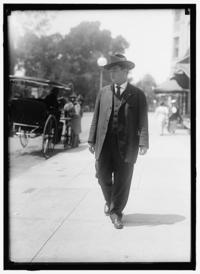 Big Bill Haywood c. 1915. |
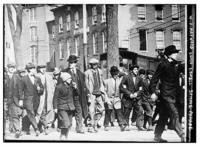 William D. Haywood Leads a Strike in Lowell, Massachusetts in 1912. Strike by textile workers. Library of Congress Prints and Photographs Division, LC-DIG-ggbain-10357. |
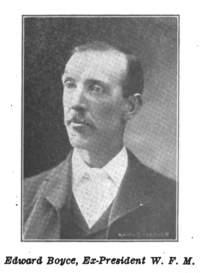 Edward Boyce. Edward Boyce was a founder and the first president of the Western Federation of Miners. He served as president of the WFM from 1896 to 1902. Boyce chose William Haywood to take the position of secretary-treasurer of the WFM. Boyce was born in County Donegal, Ireland and came to the United States at age 19. |
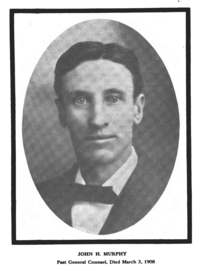 John H. Murphy. John H. Murphy (1862 - 1908) was general counsel for the Western Federation of Miners. Murphy joined Clarence Darrow and Edmund F. Richardson to argue on behalf of Haywood, Moyer and Pettibone before the United States Supreme Court in Pettibone v. Nichols, 203 U.S. 192 (1906). This was the very controversial decision involving the appeal of the arrest and extradition to Idaho of Haywood, Moyer, and Pettibone for the murder of Frank Steunenberg. Murphy died of tuberculosis on March 3, 1908. |
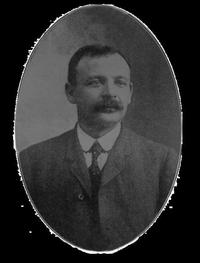 William E. Trautmann. William Ernest Trautmann was born in New Zealand in 1869 to German-American parents and raised in Europe. He emigrated to the United States from Germany in the late 1890s and settled in Ohio, where he worked for the Brewery Workers Union (BWU) and joined the Socialist Party of America. He left the BWU and helped found the Industrial Workers of the World (IWW) in 1905. He served as the IWW's secretary-treasurer and a member of its first general executive board. It is not clear when Trautmann died. After Haywood, Moyer and Pettibone were arrested on February 17, 1906 and held pending trial, sharp differences between Haywood and Moyer began to get worse. Their animosity towards each other was exacerbated later in 1906 when a struggle broke out within the IWW between more moderate members and more radical members. Haywood sided with the radicals referred to as "revolutionists" and Moyer sided with the more moderates referred to as "reformists." Trautmann also sided with the revolutionists. Around February 21, 1906 Clarence Darrow and William Trautmann met in Chicago. Trautmann informed Darrow that the IWW and organized labor wanted the accused to get the best legal defense they could and he asked Darrow if he would defend them. Darrow did not accept right away. On February 26 Darrow met with James A. Kirwan, a member of the WFM's executive committee, J.C. Williams, vice president of the Western Federation of Miners, and Edmund Richardson in Denver. It was reported after this meeting that Darrow agreed to help defend Haywood, Moyer and Pettibone as an associate counsel. |
 Edgar Wilson. Edgar Wilson (1861- 1915) was a leading citizen of Boise. Wilson was a member of the constitutional convention that framed the Idaho State constitution in 1890. He was also an attorney, banker, former congressman and a former law partner of Fremont Wood the trial judge in William Haywood trial. They had been law partners from 1884 until November 1895. Two days before the trial began Wilson surprised Judge Wood when he informed him that he had been asked to join the defense team. Wilson asked if this would be an embarrassment to the judge. Judge Wood recounted that he was "somewhat stunned" at the news but immediately decided that their friendship would not affect the case. Clarence Darrow and Haywood defense team shocked the courtroom when Edgar Wilson appeared sitting at the defense table at the beginning of the trial. http://en. wikipedia.org/ wiki/File: Edgarwilson.png 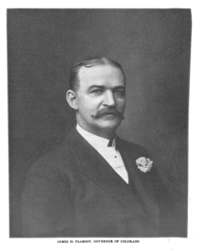 James H. Peabody. James Hamilton Peabody (1852 - 1917) was the governor of Colorado from 1903 to 1905. | |
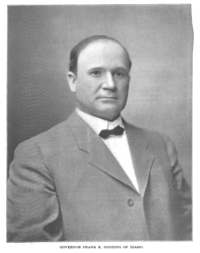 Governor Frank Gooding. Frank Gooding (1859 - 1928) was the Republican governor of Idaho from 1905 - 1908. He played a key role in the investigation into the assassination of former governor Frank Steunenberg and he met frequently with the lead Pinkerton detective James McParland. Gooding served as a United States Senator for Idaho from 1921 until his death in 1928. Photo from The Pacific Monthly: A Magazine of Education and Progress (1906). |
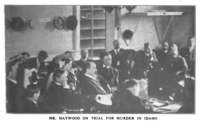 Big Bill Haywood on Trial. Haywood is in the center, Edmund Richardson is to the front and right of Haywood and Clarence Darrow is behind Richardson with his hand to his face. |
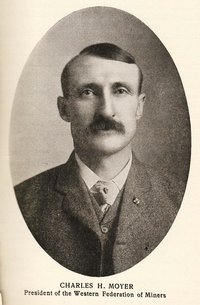 Charles H. Moyer. During the investigation into the murder of Frank Steunenberg, James McParland and the other Pinkerton agents, used code names to refer to individuals in case their messages were intercepted. The three main suspects were given reptile names. Moyer was called "Copperhead." |
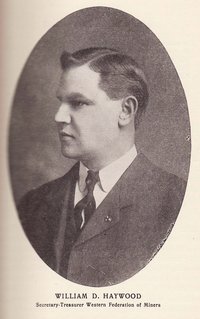 William D. Haywood. During the investigation into the murder of Frank Steunenberg, James McParland and the other Pinkerton agents, used code names to refer to individuals in case their messages were intercepted. The three main suspects were given reptile names. Haywood was given the code name "Viper." |
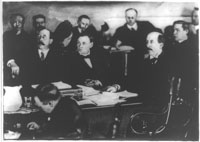 Edgar Wilson, Clarence Darrow, Edmund Richardson, and William Haywood. Defense team with their client William Haywood. Library of Congress https://www. loc.gov/resource/ cph.3a35319/ |

